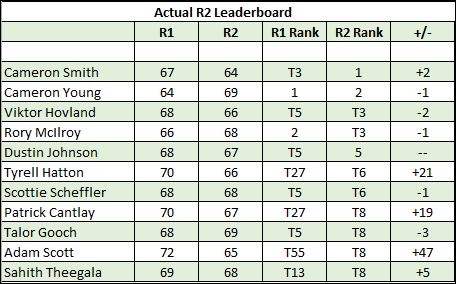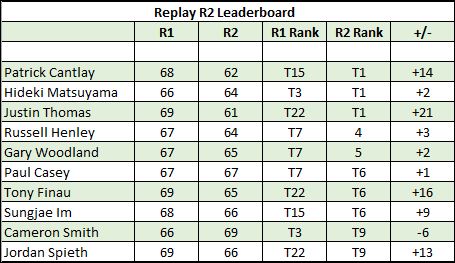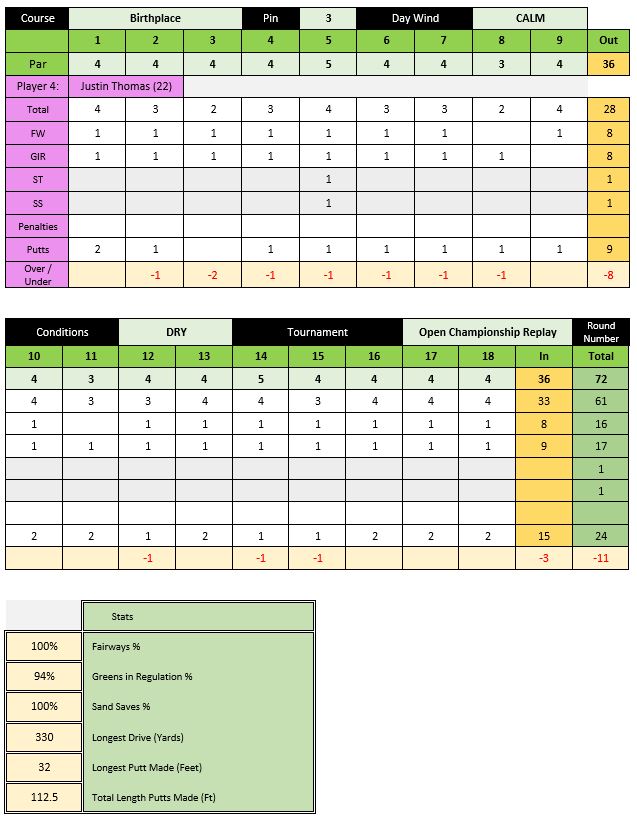In this post, I’ll be covering several things: (1) the results of my replay of the 2022 Open Championship at St. Andrews (Birthplace), (2) some commentary on speed of play using Game Caddie 5.0 and 5.1, and (3) a preview of what to expect in version 5.2.
Previous posts on this tournament discussed setting up the Game Caddie for such a replay and the results of round 1. Details of the actual 2022 Open Championship were also discussed to provide context. Keeping in that vein, let’s look at how round 2 unfolded on July 15, 2022.
Actual Event
In the actual round 2, Cameron Smith (64), the low-scorer for the day, overtook Cameron Young (69) for first place. By the end of the day, Smith had a total tournament score of 13-under par, and Cameron Young moved to second place with a total score of 11-under.
Rory McIlroy (68) fell from first place after round 1 into a tie for third with Viktor Hovland (66), who moved up from a tie for fifth. Both players ended the round with a total score of 10-under par.
Dustin Johnson (67) took sole ownership of fifth place at 9-under par in round 2. Tyrrell Hatton (66) and Scottie Scheffler (68) tied for sixth with a total score of 8-under. Patrick Cantlay (67), Talor Gooch (69), Adam Scott (65), and Sahith Theegala (68) all tied for eighth place with a total score of 7-under.
Adam Scott’s 65 was the 2nd lowest score for the round, a stroke behind Cameron Smith’s 64. Here’s a comparison of results between rounds 1 (R1) and 2 (R2) for the top of the leaderboard.

Replay
The replay featured Calm winds, the Pin located at position 2, and Dry course conditions (+10 FW Roll / +5 Green Roll). These favorable factors produced as good or better scores for the replay field, overall.
Justin Thomas (61) surged to a 3-way tie at the top of the leaderboard with Hideki Matsuyama (64) and Patrick Cantlay (62) — all at a total of 14-under par after round 2. Russell Henley (64) took sole possession of fourth place at 13-under, and Gary Woodland (65) finished fifth on the day at 12-under.
Paul Casey (67), Sungjae Im (66) and Tony Finau (65) tied for sixth with a total score of 10-under par. Cameron Smith (69) fell from a tie for third place in the first round to a tie for ninth at 9-under.
Jordan Spieth (66) climbed up to a tie for the ninth spot in the second round after being tied for 22nd place in the first. Both Rory McIILroy (71) and Tommy Fleetwood (72) fell out of the top 10 on the leaderboard, dropping to T11 and T15 respectively.
Here’s what the top of the leaderboard for the replay looks like after round 2:

Noteworthy Replay Events
Justin Thomas’s 61 matches my previous APBA best round by Bryson DeChambeau during my 2020 Players Championship simulation at TPC Sawgrass (The Stadium Course). Thomas might have broken the record by making one or more putts of 12 feet or less on the last three holes, yet missed them all.
Nevertheless, Thomas was deadly with the putter in round 2, taking only 24 putts in all. Please consider that the replay tournament is using APBA’s more difficult Major Tournament Putting boards, and the average number of putts for the field for this tournament replay is 31.5 putts per round.
In his record-tying round, Thomas finished the front nine at 8-under par, which included an eagle on hole no. 3 (a 398-yard par 4) 9 birdies, and no bogies. Here’s his scorecard for round 2:

In other categories, Tony Finau set my APBA golf longest putt made record, in round 2, by sinking a putt of 110 feet. While that may seem like a very long putt on a typical APBA course, it is not for Birthplace. On some of Birthplace’s huge double greens, my replay golfers have attempted putts from as long as 250 feet. (I’m not sure I could even see the hole from that distance!)
Finally, Keith Mitchell owns the dubious honor of my first 5-putt. Many are tied with 4 putts, but only Keith has taken 5 green knocks to get down.
Full tournament replay results through round 2 appear in the PDF document below.
Speed of Play
The first two rounds have been played with Calm winds and with Game Caddie 5.0 and 5.1. These versions of the Game Caddie are specifically designed to simplify repetitive aspects of selecting a wind result for each hole and incorporating that information into shot planning and execution. The net result is faster and more accurate play.
With ‘Standard’ as the wind setting in the Configuration Settings menu and ‘Calm’ selected on the Conditions tab, all wind rolls were taken automatically with the effects shown in the Caddie tab for each player. Using the full set of Master Game rules (amended by several local rules as described previously), a typical round with three APBA golfers could be played in less than 90 minutes.
Let’s face it folks, I am not a computational math wiz, and my eye sight is not what it used to be. Keeping track of all the plusses and minuses from lie, wind, course notes, and shot results for the many dice rolls required and then counting out all the squares on the course boards many times over is very taxing–at least for me. Doing it accurately, time and again, for multiple players over 18 holes is just a bridge too far on most days. The use of Game Caddie 5.0 and 5.1 did speed up play considerably on Birthplace for rounds 1 and 2 and made it more fun as well.
Preview of Round 3 and Game Caddie 5.2
Round three is up next and the Wind is going to be Moderate. For Birthplace that means needing to roll dice for the wind for each player and on each shot. I will be using the not-yet-released version, Game Caddie 5.2, which features an upgrade to the ‘Modified’ wind setting in the Configuration Settings menu.
With version 5.2, upon opening the All-in-One menu, the Wind Rolls menu will pop up each time there is a shot more than 45 yards from the flag, and a wind roll will occur automatically. (No more need to click the Roll button on the Wind Rolls menu.) All the user will have to do is look up the Wind roll result on the Birthplace course board wind table for the hole and type the result (e.g., +15 Carry / 10 Left) into the ‘User Specified’ boxes on the Wind Rolls menu.
Without the Game Caddie, think about how many dice rolls it would take to get a wind result for a pairing of 3 – 4 players for each shot for a round. Then add to that the mental effort it requires to calculate the net result of all those rolls each time. Finally, extend that estimate to the entire field of players competing in a round. That’s a whole lot of dice rolling and mental math–most of which can be avoided by using the Game Caddie.
Coming up . . . a post on the effectiveness of Game Caddie 5.2 on gameplay.
Great recap. Latest Game Caddie sped up my game. Looking forward to yet another great update.